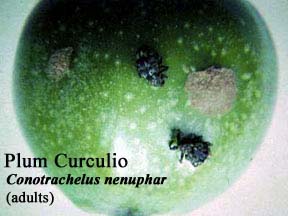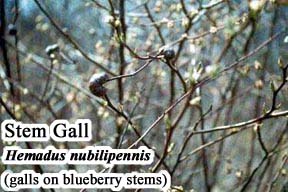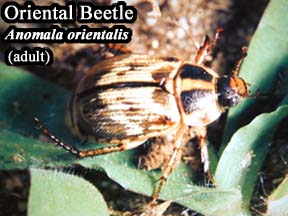Blueberry (Vaccinium)
Plant Health Problems
Diseases caused by Fungi:
Mummy berry, Monilinia vaccinii-corymbosi.
Mummy berry is becoming increasingly important although it is fortunately not a problem in all blueberry plantings. The fungus attacks new growth, foliage, and fruit and can result in extensive losses. The disease cycle begins in spring when the fungus produces spores on mummified fruit from the previous season. These spores infect young tissues causing them to turn brown, wilt and die, often mimicking frost damage. As these infections become established, the fungus produces a second type of spore which is spread by rain, wind, and pollinating insects to blossoms and other new tissues. The fungus grows in these tissues and invades the developing fruit. Infected fruit take on a characteristic salmon or creamy tan color by mid-summer and fail to ripen. These infected fruit shrivel and drop to the ground where they mummify and become the overwintering source of the fungus for the next year.
Sanitation and culture are very important for disease control and help to avoid the buildup of the fungus. If possible, rake and remove mummified berries from the vicinity of the planting. Alternative measures include covering fallen mummies with approximately 2 inches of soil or mulch or disking the soil beneath the planting to bury the mummies. These steps should be completed before budbreak. The blueberry varieties Jersey, Dixi, Darrow, Collins, and Bluetta are considered resistant. When the disease is severe and/or the weather is wet between budbreak and bloom, fungicide sprays are often necessary for effective disease management. Among the compounds registered for use in Connecticut are triforine, captan, and chlorothalonil. Consult the label for dosage rates, safety precautions, and days to harvest intervals. For more information, see the fact sheet on Disease Control for the Home Blueberry Planting.
Botrytis blight and berry rot, Botrytis cinerea.
This disease is present every year but is usually more serious during cool, wet weather. The fungus overwinters on dead twigs or in organic matter in the soil. In spring, it produces spores which attack new shoots and blossoms. Affected plant parts often appear water-soaked and turn brown; blighted blossoms cling to flower clusters. The berry rot stage appears on ripening fruit which had been infected earlier in the season. This disease is usually more serious after periods of rainy or foggy weather during blossom when infected twigs and blossoms become covered with the gray fuzzy mass of the fungus.
Control of Botrytis blight can be achieved by pruning and removing any dead twigs or branches during the dormant season. Cultural practices such as adjusting soil pH and avoiding over-fertilization (rapidly growing, over-fertilized shoots are prone to infection) help to minimize the effects of this disease. When the planting has a history of disease or when wet weather persists during bloom, fungicide sprays help to reduce the amount of infection. Among the compounds registered for use in Connecticut are captan and fenhexamid. Consult the label for dosage rates, safety precautions, and days to harvest intervals. For more information, see the fact sheet on Disease Control for the Home Blueberry Planting.
Phomopsis twig blight, Phomopsis spp. (including P. vaccinii).
This disease is frequently more severe following winters characterized by excessive temperature fluctuations and associated injuries. The fungus overwinters in cankers or dead twigs and produces spores in the spring, primarily during bloom. Rain is necessary for spore release and warm temperatures (70-80F) are favorable for infection. Symptoms first appear on smaller twigs but the disease can spread into larger branches and may even infect the crown. Younger tissues often do not show any symptoms at first, but may suddenly wilt and collapse in summer. The pith and wood of these infected twigs become discolored.
Since bushes which are weakened or predisposed by winter injury or are in poor vigor are most vulnerable, measures to maintain optimum plant growth and vigor help to minimize the effects of this disease. In addition, all blighted or discolored wood should be pruned and removed from the vicinity of the planting during the dormant season or whenever newly infected tips appear. Some cultivars that appear to have some resistance are Bluejay, Jersey, Bluetta, and Darrow. Fungicide sprays during the growing season can provide some control. Additionally, lime sulfur is registered for use in Connecticut. Applications in late fall (after leaves drop) or in spring when the plants are still dormant have been reported to reduce available inoculum. Consult the label for dosage rates, safety precautions, and days to harvest intervals. Pruning is still the key management tool. For more information, see the fact sheet on Disease Control for the Home Blueberry Planting.
Insect Problems:
Blueberry maggot, Rhagoletis mendax.
This maggot commonly infests blueberry and huckleberry. The adult fly is about 1/5" long with a distinctive black pattern on otherwise clear wings, and with a black and white striped abdomen. Females lay eggs under the fruit skin just as it begins to ripen. Larvae are white, legless maggots that feed within the fruit. They are 1/4" long at maturity. Two or three sprays of malathion, which is among the compounds registered for control of this pest in Connecticut, applied at ten day intervals, starting when the berries begin to turn blue has helped manage these maggots. Consult the label for dosage rates and safety precautions. In small plantings it may be possible to control this pest with yellow sticky traps.
Blueberry bud mite, Acalitus vaccinii.
This 4-legged eriophyid mite is so small that it can be seen only with a microscope. Eriophyid mites are elongate and conical with their legs all at the broad end along with the mouthparts. Infestations cause distorted flower buds or even stop bud development. Feeding causes the skin of berries to be rough. Mites are present throughout the season.
'Burlington' apparently escapes damage by this pest. Malathion mixed with ultra-fine horticultural oil, which are among the compounds registered for control of this pest in Connecticut, sprayed on buds after harvest, may be effective. Consult the label for dosage rates and safety precautions.
Blueberry budworm, Rhynchagrotis anchocelioides.
This is one of the cutworms that develop in weeds under the bushes. The larvae may eat fruit buds. Clean cultivation reduces the abundance of bud worms, and cutworm baits have given good control.
Blueberry flea beetle, Altica sylvia.
This bronze beetle, about 1/4" long, feeds on the margins of blueberry leaves in midsummer. It is not common and no control has been required.
Blueberry thrips, Frankliniella vaccinii.
The small slender thrips attack the plants early in the spring, feeding on terminal leaves. These leaves remain rolled together and the thrips continue feeding all summer.
Spraying with malathion, which is among the compounds registered for control of this pest in Connecticut, should be effective against these thrips if the spray penetrates the rolled leaves. Consult the label for dosage rates and safety precautions.
Cherry fruitworm, Grapholita packardi.
This worm is an occasional pest of blueberries, and may be controlled by sprays used for the cranberry fruitworm.
Cranberry fruitworm, Acrobasis vaccinii.
These worms feed on berries, entering at the stem end and cause the fruit to ripen earlier. They migrate from one fruit to another, even after the berries have been harvested. The moths pass the winter in the cocoon stage in nearby weeds and plant debris.
In a small planting, picking the easily identified, infested fruit clusters and destroying them can provide control. Also, destroying surrounding weeds and plant debris removes overwintering sites. Among the compounds registered for control of this pest in Connecticut are Bacillus thuringiensis (Bt) and malathion. Sprays of Bt var. kurstaki when larvae are small or malathion in the late bloom stage and again a week later have controlled these pests. Consult the label for dosage rates and safety precautions.
Cranberry rootworm, Rhabdopterus picipes.
These small white grubs with a brown head may feed on the roots of blueberries, cranberries, and other bog plants. Bog land may be infested before cultivated plants are set. The beetle is mahogany brown and about 1/4" long. It feeds on foliage early in the summer. There is one generation a year.
Plowing new land a full year before planting should control infestation. See Potato, wireworms.
Cranberry weevil, Anthonomus musculus.
Also called the blueberry blossom weevil, the adult is between 1/16 and 1/8" long, and dark brown or black in color. These weevils cut into swelling leaf and fruit buds. Eggs are laid in the flowers, and the grubs eat the flower parts. There may be a second generation that feeds on leaves. The adults overwinter in sheltered areas.
Clean cultivation and destruction of trash on surrounding land helps reduce the number overwintering. Remove any wild blueberries that are nearby. Spraying or dusting with methoxychlor or malathion, which are among the compounds registered for control of this pest in Connecticut, just as the buds swell has killed overwintering beetles. Consult the label for dosage rates and safety precautions.
Datana worm, Datana angusii.
This is a relative of the redhumped caterpillar on apple. Since it feeds in colonies, destruction by hand is possible. If abundant, methoxychlor or rotenone sprays or dusts, which are among the compounds registered for control of this pest in Connecticut, may be used. Consult the label for dosage rates and safety precautions.
European corn borer, Ostrinia nubilalis.
These larvae may bore in blueberry after migrating from infested weeds. Control is usually unnecessary.
This insect feeds not only on corn, but also on other crop plants (including potatoes, peppers, and beans), many weeds, and on a variety of other herbaceous plants. Larvae tunnel in the stems, causing them to break. The larva is pale white or gray with black tubercles and is not more than an inch in length when fully grown. Adults have a wingspread of an inch or so and are buff to brown in color. There are usually two generations annually. Eggs are laid on the underside of leaves and the larvae tunnel into stems and pupate in the burrows. Second generation larvae and those of the single generation corn borer overwinter in the stems and pupate in the spring.
The parasitic wasp, Trichogramma, has been used for control. This tiny wasp attacks the egg masses of the corn borer, and the eggs of other caterpillars, too. Be sure to purchase the insects from a reputable supplier and make sure the strain you purchase is known to be well adapted to attacking corn borer.
Fall webworm, Hyphantria cunea.
This pest occasionally attacks blueberries. Webworms cause minor foliar damage on apple trees. Caterpillars build a loosely constructed tent on the ends of infested branches. Tents, which usually are most abundant in the northeastern part of the state, are visible in late summer. Summer foliar sprays of Bacillus thuringiensis var. kurstaki, which is among the compounds registered for control of this pest in Connecticut, controls this minor pest. Consult the label for dosage rates and safety precautions. See Pear for additional details of the life history.
Leafrollers.
Several species have been recorded from blueberries. They are seldom abundant enough to require control.
 Plum curculio, Conotrachelus nenuphar.
Plum curculio, Conotrachelus nenuphar.
This pest may also attack blueberry. For a description and life cycle information, see Plum. Control is the same as for the cranberry fruitworm.
Putnam scale, Diaspidiotus ancylus.
This round scale is the most common attacking blueberries. Damage is worst on older bushes, as well as on older branches within bushes, where scales are protected from spray by rough bark. It may feed on fruit. This scale also occurs on forest trees.
Pruning to remove old, heavily infested wood helps keep damage to a minimum. Dormant sprays using ultra-fine horticultural oil, which is among the compounds registered for control of this pest in Connecticut, have managed this and other scales. Consult the label for dosage rates and safety precautions.
Redhumped caterpiller, Schizura concinna.
This pest may also attack blueberries. If control is required, rotenone, which is among the compounds registered for use against this pest in Connecticut, may be used. Consult the label for dosage rates and safety precautions.
Redstriped fire worm, Gelechia trialbamaculella.
The young larvae are pale green, and later develop reddish brown stripes. Fully grown larvae are uniform brown in color. They fasten two or three leaves together and feed within.
Spraying with rotenone, which is among the compounds registered for control of this pest in Connecticut, before the leaves are webbed together should be effective against this insect. Consult the label for dosage rates and safety precautions.
Sharpnosed leafhopper, Scaphytopius magdalensis.
This small leafhopper is a carrier of blueberry stunt. It is rare in Connecticut at present.
Stem borer, Oberea myops.
This slender beetle sometimes girdles blueberry shoots. The adult is about 1/2" long, and light brown with black wing covers and eyes. The girdling occurs when the adults lay eggs in the stems. The grubs bore into the stem and require three years for development.
Cutting and burning, if allowed, recently wilted shoots destroys the young grubs.
 Stem gall, Hemadus nubilipennis.
Stem gall, Hemadus nubilipennis.
These kidney-shaped, 3/4 to 1 1/4" galls are produced by larvae of a chalcid wasp feeding in the stem. Mature larvae pupate and overwinter in the gall. In spring, the tiny delicate winged adults bore a hole to exit the gall. Eggs are laid on new shoot growth.
A degree of control can be achieved by cutting and burning the galls while pruning. If chemicals are sprayed for other pests, they generally control this pest.
Terrapin scale, Mesolecanium nigrofasciatum.
This lecanium scale is much larger and more convex than other scales on blueberry. It secretes large quantities of honey dew on which sooty mold fungus develops. It is seldom a serious pest, but may be controlled by the treatment for Putnam scale.
Tip borer, Hendecaneura shawiana.
The tiny moth emerges early in June and lays eggs on the lower surface of young leaves. After hatching, the pink larvae bore into the current year's wood. Each larva forms a tunnel 8 - 10" long, cutting off water to growth beyond it. These shoots wilt and die back. The next year's fruit production is consequently reduced as a result. Sprays for the cranberry fruitworm will also control this pest.
 White grubs.
White grubs.
Grubs of rose chafer, Macrodactylus subspinosus, Japanese beetle, Popillia japonica and oriental beetle, Anomala orientalis, feed on the roots of blueberries, causing a weakening of the plants. Oriental beetle larvae are the most common root feeders while rose chafer and Japanese beetle cause most damage as adults feeding on foliage.
These beetles begin to emerge the latter part of June but their greatest abundance is usually about the middle of July. In certain seasons, particularly after drought periods, they may disappear altogether. The eggs are laid in July in the soil, and the grubs feed on roots near the surface, going downward to a depth of about a foot to overwinter. Late in April, they return to the surface, feed for a time, then enter the prepupal stage, and pupate in late May or early June. From 2 to 4 weeks later, the adults emerge. There is one generation each year. Acephate, azadirachtin, or malathion, which are among the compounds registered for use against this pest in Connecticut, sprays will provide control of the adults. Consult the label for dosage rates and safety precautions. There are no products labeled for white grubs in blueberry. Insect pathogenic nematodes, especially Heterorhabditis species, are being studied for control of these root-feeding grubs. Treatment of nearby lawn areas should reduce the numbers of beetles.

